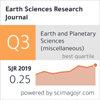Fracture variability in basalts and its effect on river erosion: a case study in the Paraná Volcanic Province
IF 0.5
4区 地球科学
Q4 GEOSCIENCES, MULTIDISCIPLINARY
引用次数: 1
Abstract
How to cite item Lima., A., G., Pelegrina, M. A., & Pontarolo, M. (2021). Fracture variability in basalts and its effect on river erosion: a case study in the Paraná volcanic province. Earth Sciences Research Journal, 25(1), 13-20. DOI: https:// doi.org/10.15446/esrj.v25n1.74167 The variation in the structural characteristics (cooling joints and tectonic fractures) of basaltic flows implies potential variability in the intensity of erosion by plucking. The erosive behavior of the rivers that sculpt these areas depends on their interaction with the diverse fracture systems. In view of this, we analyzed the effect of fracture variability (tipology, density and direction) in basalts on erosion in a bedrock river reach located in the Continental Volcanic Province of the Paraná Basin, southern Brazil. The fracture density and fracture direction were evaluated through field photogrammetry in seven sample areas distributed along a reach of 120 m. The fracture direction and main erosion axes were also surveyed by remote piloted aircraft (RPA) aerial imaging. The main erosion axes coincide with the principal fracture directions (tectonic fractures), which are disposed obliquely to the channel flow direction, making an average angle of 50°. The small, more abundant, and multidirectional cooling joints control the plucking process, but do not determine the erosion direction. The fracture density systematically decreases upstream from 9.62 to 3.73 m/m2, probably related to distance from a structural lineament which river crosses downstream. The higher fracture density favors more intense plucking due to decrease in the size of the rock blocks. The lower fracture density limits the plucking and favors the macroabrasion, mainly if associated with vesicular-amygdaloidal basalt. ABSTRACT Fracture variability in basalts and its effect on river erosion: a case study in the Paraná volcanic province玄武岩的断裂变异性及其对河流侵蚀的影响——以巴拉那火山岩省为例
如何引用利马项目。,A.,G.,Pelegrina,M.A.和Pontaolo,M.(2021)。玄武岩的断裂变异性及其对河流侵蚀的影响:以巴拉那火山省为例。《地球科学研究杂志》,25(1),13-20。DOI:https://DOI.org/10.15446/esrj.v25n1.74167玄武岩流结构特征(冷却缝和构造裂缝)的变化意味着拔出侵蚀强度的潜在变化。塑造这些区域的河流的侵蚀行为取决于它们与不同断裂系统的相互作用。鉴于此,我们分析了玄武岩断裂变异性(岩性、密度和方向)对巴西南部巴拉那盆地大陆火山省基岩河段侵蚀的影响。通过现场摄影测量对分布在120m河段的七个样本区的裂缝密度和裂缝方向进行了评估。还通过遥控飞机(RPA)航空成像对裂缝方向和主要侵蚀轴线进行了测量。主侵蚀轴线与主断裂方向(构造断裂)一致,主断裂方向与河道流向倾斜,平均角度为50°。较小、更丰富和多向的冷却接头控制着拔毛过程,但不能决定侵蚀方向。上游的裂缝密度从9.62米/平方米系统性地降低到3.73米/平方英尺,这可能与河流下游穿过的结构线理的距离有关。由于岩块尺寸的减小,较高的裂缝密度有利于更强烈的拔除。较低的断裂密度限制了拔出,并有利于宏观磨损,主要与泡状杏仁状玄武岩有关。玄武岩的断裂变异性及其对河流侵蚀的影响——以巴拉那火山省为例
本文章由计算机程序翻译,如有差异,请以英文原文为准。
求助全文
约1分钟内获得全文
求助全文
来源期刊

Earth Sciences Research Journal
地学-地球科学综合
CiteScore
1.50
自引率
0.00%
发文量
0
审稿时长
>12 weeks
期刊介绍:
ESRJ publishes the results from technical and scientific research on various disciplines of Earth Sciences and its interactions with several engineering applications.
Works will only be considered if not previously published anywhere else. Manuscripts must contain information derived from scientific research projects or technical developments. The ideas expressed by publishing in ESRJ are the sole responsibility of the authors.
We gladly consider manuscripts in the following subject areas:
-Geophysics: Seismology, Seismic Prospecting, Gravimetric, Magnetic and Electrical methods.
-Geology: Volcanology, Tectonics, Neotectonics, Geomorphology, Geochemistry, Geothermal Energy, ---Glaciology, Ore Geology, Environmental Geology, Geological Hazards.
-Geodesy: Geodynamics, GPS measurements applied to geological and geophysical problems.
-Basic Sciences and Computer Science applied to Geology and Geophysics.
-Meteorology and Atmospheric Sciences.
-Oceanography.
-Planetary Sciences.
-Engineering: Earthquake Engineering and Seismology Engineering, Geological Engineering, Geotechnics.
 求助内容:
求助内容: 应助结果提醒方式:
应助结果提醒方式:


